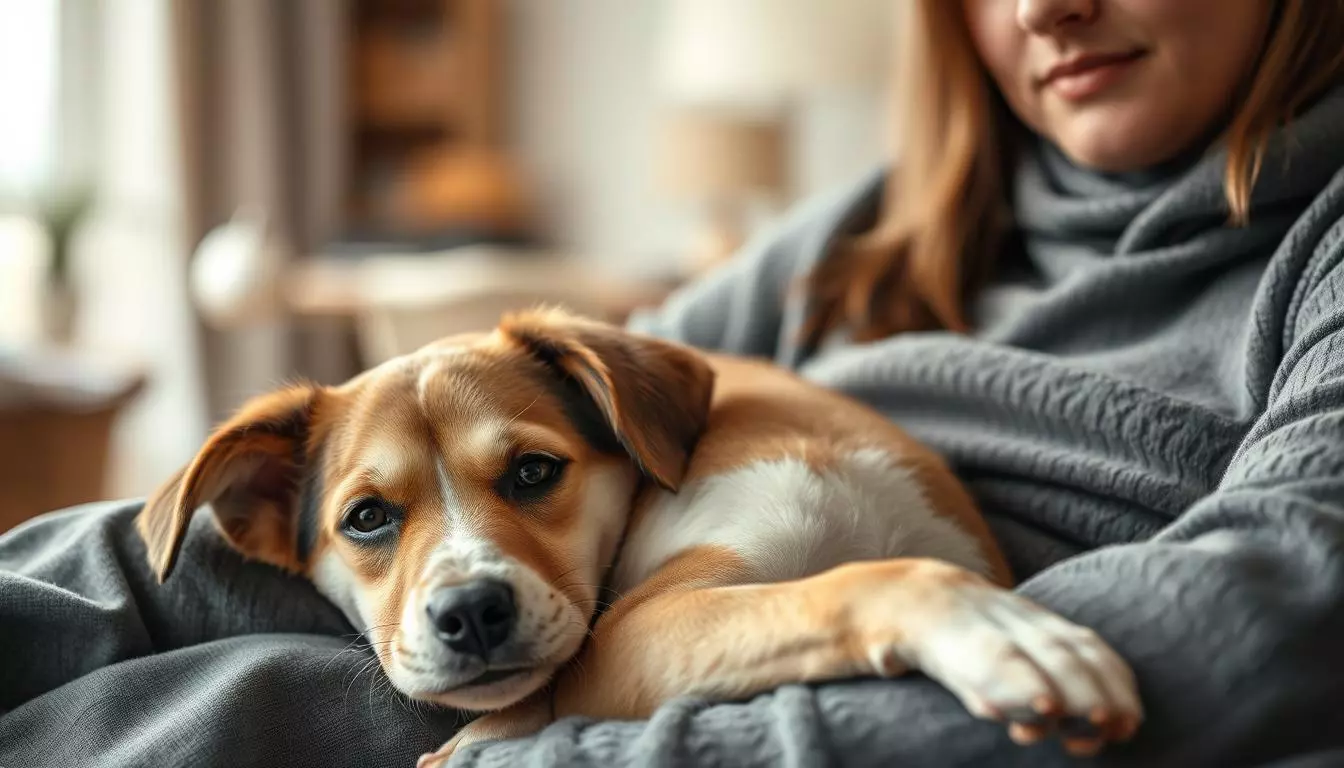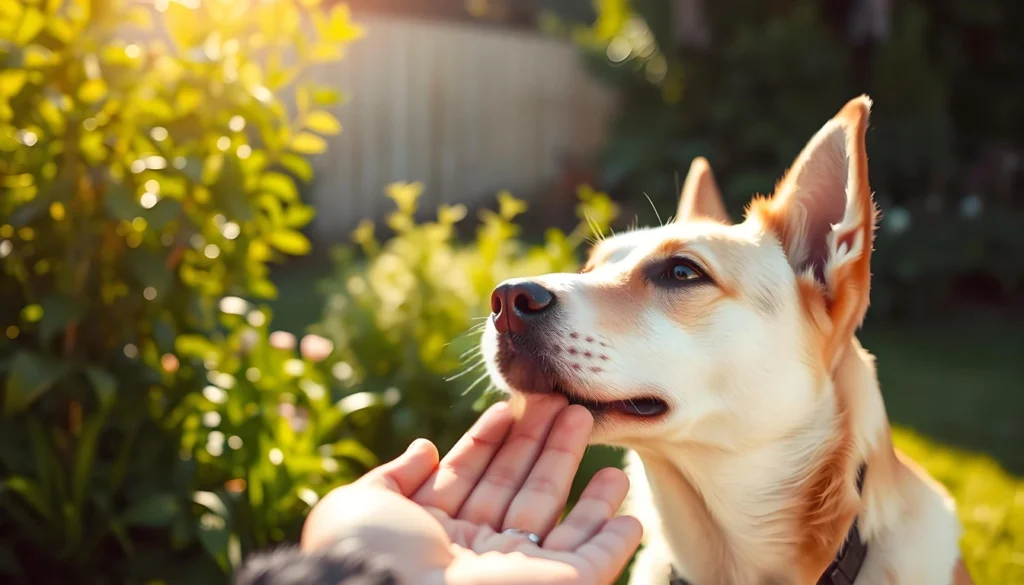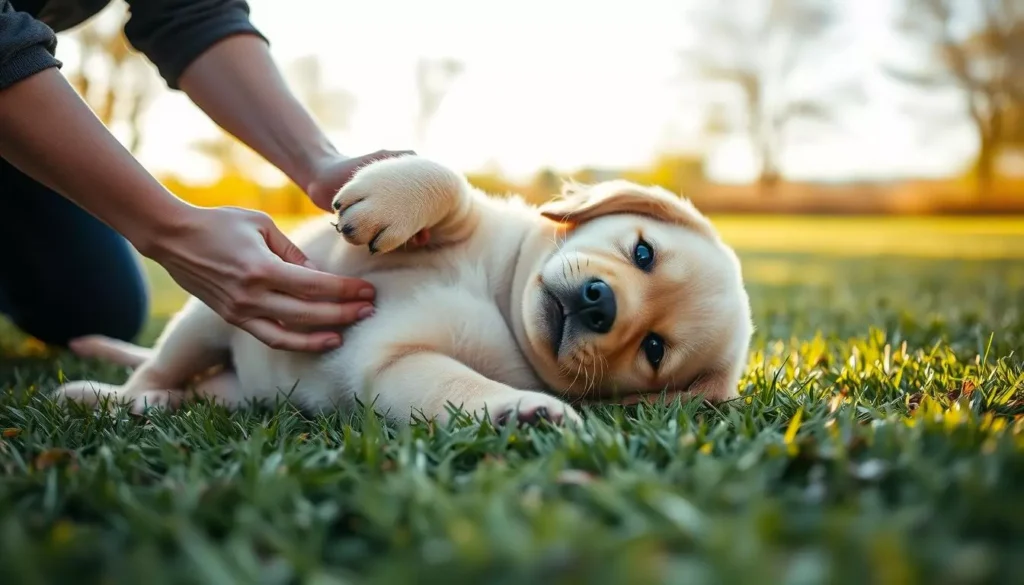Have you ever noticed how your dog seems perfectly relaxed with you, but turns into a ball of energy around strangers? It’s a puzzling phenomenon that many pet owners experience. It often leaves us questioning our dog's behavior. I’ve watched as my furry friend settles in quietly beside me, yet becomes jittery the moment a guest walks through the door.
This article delves into the reasons behind the differences in dog behavior. It explores what might be causing my pup's calm demeanor with me but not with others.
Understanding why my dog exhibits calmness around me while reacting with anxiety or excitement with unfamiliar faces can offer essential dog training tips. It’s not just about their personality – several factors can contribute to this behavior. Let’s unpack this dynamic and learn how our relationships with our dogs can reshape their reactions to the world.
Key Takeaways
- Dogs often feel secure with their owners, leading to calm behavior.
- Familiar environments play a significant role in dog anxiety levels.
- Socialization and exposure to new situations can help mitigate anxiety.
- Understanding dog behavior is crucial for effective training.
- Establishing trust helps reduce anxiety in dogs.
Understanding Your Dog's Behavior
Knowing how your dog behaves is key for any dog owner. By watching their body language, you can understand their feelings and reactions. Dogs show their emotions through their posture, tail, and face.
A wagging tail usually means they're excited. But a tucked tail might show fear or anxiety. It's important to know these signs.
When dogs feel comfortable, they lie down, play, or come to you relaxed. But if they seem tense or hide, they might be feeling scared or overwhelmed. Spotting these signs helps create a better space for them.
Every dog is different, and their behavior changes based on who they know. Getting to know these differences is vital for building trust and a strong bond. As I learn more about their body language, I can help my dog feel safe and calm in different situations.
The Importance of Trust in Dog Relationships
Trust is key in dog relationships, creating a strong bond between me and my dog. It makes my dog feel secure and comfortable. Building trust means having positive interactions that show my dog I understand and care for them.
Respecting my dog's needs changes their behavior for the better. This approach strengthens our bond, making my dog trust me more. Dogs feel safe and valued in such relationships.
Understanding the role of trust is vital for pet owners. It helps in training and improves our daily life together. Trust has made our interactions calmer and more enjoyable for both of us.
Factors Influencing Dog's Behavior
Understanding a dog's behavior is complex. It involves recognizing how different elements shape their reactions. Each dog is unique, with traits that combine to form their behavior patterns. Some key factors include:
- Environment's impact on dogs: Where a dog grows up greatly affects their temperament. Dogs raised in loud or chaotic places may get anxious around new people or situations.
- Past experiences: A dog's past interactions can deeply affect them. For instance, a dog that had bad experiences with kids might be more cautious around them later.
- Socialization: Socializing a dog early and often helps them adapt. It reduces fear when they meet new things.
- Temperament: Every dog has a natural personality that shapes their behavior. Some are naturally timid, while others are very confident.
These elements help us understand how dogs react in different situations. They also help us see how our dog acts around us versus others. Knowing what might upset our dog lets us create a better environment for them.
Why Is My Dog Calm Around Me But Not Others?
I often wonder why dogs act differently around family compared to others. The comfort level with family members plays a big role in this. Dogs see their families as their pack, building trust and feeling safe.
This bond lets them relax and show calm behavior in familiar places. When with family, dogs often act as they usually do and seem more relaxed.
Comfort Level with Family Members
The relationships a dog has with its family greatly affect their mood. My dog feels safest with those they see often. Familiar scents, voices, and routines make them feel calm.
As family, we give consistent responses that dogs know. This makes them feel calm and stable.
Unpredictable Reactions from Guests
Dog behavior with guests can be hard to predict. Visitors might make dogs excited. Their different scents, voices, or movements can confuse or stress my dog.
Teaching guests how to interact with dogs can make things better. Encouraging calm greetings and gentle petting helps reduce stress when new people come.
Canine Socialization and Its Impact
Canine socialization is key in shaping a dog's behavior and mood. It involves exposing dogs to different places, people, and experiences. This helps them develop good social behavior.
By socializing your dog well, you can lower the chance of fear and anxiety in new situations. This makes them more adaptable and confident.
When I think about socializing my dog, I focus on regular interactions. It's important to expose them to various people and places. This can include dog parks, inviting friends over, or walks in busy areas.
Each activity helps my dog learn to handle new experiences positively.
A well-socialized dog usually shows more stable behavior. Without enough socialization, dogs might become fearful or aggressive. I've seen how crucial it is to start socializing them early, ideally between 3 and 14 weeks.
But it's never too late to start. Adding socialization to daily activities can help reinforce good behavior.
| Socialization Activities | Benefits |
|---|---|
| Group Classes | Enhances confidence and friendly interactions with other dogs |
| Visit Different Environments | Teaches adaptability to new sounds, smells, and sights |
| Invite People Over | Familiarizes your dog with various human interactions |
| Attend Community Events | Exposes dogs to large crowds and diverse situations |
Why Daily Exercise Matters for Your Dog
It's crucial to make sure my dog gets daily exercise for their health and happiness. Regular physical activity helps burn off extra energy. It also plays a big role in reducing dog anxiety by keeping them active.
When we mix up our exercises, the benefits of dog exercise really show. It's great for their overall well-being.
Burning Off Excess Energy
Exercise is good for my dog's body and mind. It helps manage their energy levels. A dog that gets enough exercise is less likely to act out due to boredom or too much energy.
Activities like long walks and playing in the park are all good. They keep my dog happy and healthy.
Reducing Anxiety through Activity
Daily exercise helps reduce my dog's anxiety. A regular routine makes them feel safer and more secure. Simple activities like fetching a ball or running with me help keep them calm.
Regular physical activity also helps my dog feel more confident. They become calmer, especially when there are guests around.
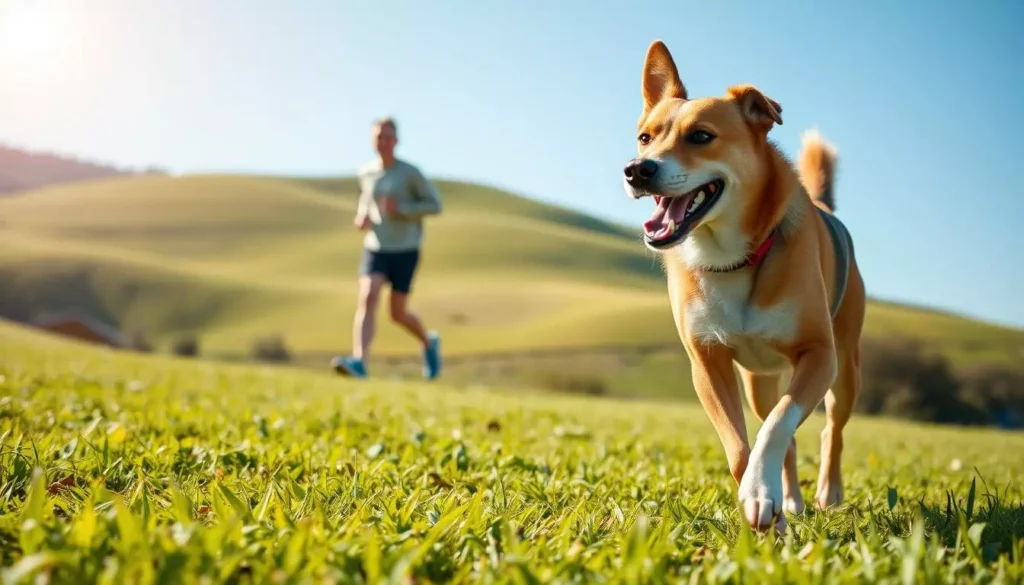
| Type of Activity | Duration | Benefits |
|---|---|---|
| Long Walks | 30-60 minutes | Promotes cardiovascular health and weight control |
| Play Fetch | 20-30 minutes | Enhances agility and provides mental stimulation |
| Aggressive Tug-of-War | 15-20 minutes | Builds strength and encourages bonding |
| Doggy Daycare | 3-4 hours | Facilitates socialization and reduces separation anxiety |
Managing Hyperactivity in Dogs When Guests Arrive
When I have guests over, my dog gets really excited. This excitement can turn into a lot of activity. To make things better, I make sure my dog gets lots of exercise before visitors come. A long walk or a fun play session helps to reduce their energy.
Then, I create a calm space for my dog. This area is a safe place for them to relax when things get too much. Keeping things calm when guests arrive also helps. Asking visitors to be gentle when greeting my dog makes things easier for everyone.
Using a leash helps manage my dog's excitement when guests arrive. It keeps them from jumping up. By setting routines for when guests come, my dog knows what to expect. This makes dealing with their excitement easier.
Creating a Structured Environment for Calmness
Creating a structured environment for dogs is key for their happiness and calmness. A regular routine makes them feel safe. This helps them handle new people and situations better. I've seen how my dog feels better when he knows what to expect.
To make a structured environment, follow these tips:
- Set specific times for meals, walks, and play. A predictable schedule makes dogs more relaxed.
- Choose a cozy spot in the house for your dog to go when stressed. It should be quiet and comfy.
- Do training sessions to teach boundaries and reinforce the dog behavioral structure. This helps dogs know their place in the home.
- Use calming aids like soft music or sprays in their safe space.
In summary, focusing on creating calmness is good for both dogs and their owners. It makes the home more peaceful. By creating a structured environment, we help dogs deal with stress and anxiety better.
Training Your Dog for Calm Greetings
Teaching your dog to be calm when guests arrive can change their behavior. A clear plan is key to success. It shows you how to train your dog to stay calm when visitors come. Remember, being consistent and patient is crucial.
Developing a Clear Training Plan
I start with a structured plan that uses different techniques. Here's a simple guide:
- Set a Quiet Environment: Start training in a quiet place where your dog feels safe.
- Introduce Controlled Greetings: Reward your dog for staying calm as visitors get closer.
- Practice Regularly: Regular training sessions help build good habits and calm behavior.
- Gradually Increase Exposure: Introduce your dog to different people one at a time to avoid stress.
- Reward Good Behavior: Use treats and praise to encourage calm greetings.
This plan makes me confident in teaching my dog to greet others calmly.
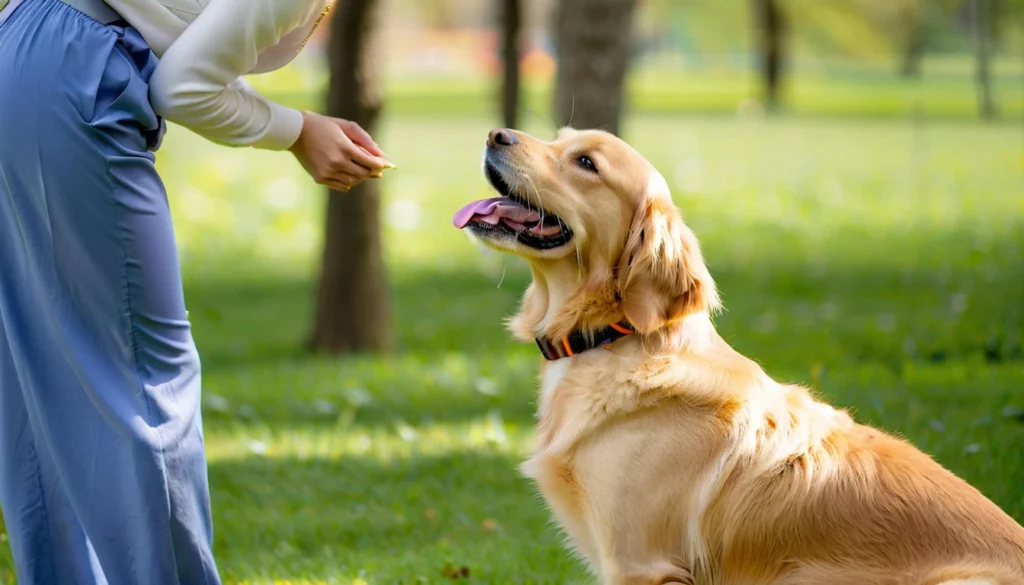
Using Leashes to Control Excitement
Leashes are key in dog training for handling excitement, like when guests come over. They let me guide and correct my dog right away. This helps keep things calm and peaceful.
Using leashes helps my dog stay calm and lowers their anxiety. It makes them feel safe, so they don't jump or bark too much. Here's how I handle greetings:
- Choose the right leash for comfort and control.
- Train my dog to sit before the door opens, rewarding good behavior.
- Practice greeting exercises with the leash to guide their movements.
- Give treats for calm behavior when guests arrive, making it a positive experience.
These methods create a calmer space for my dog and our guests. With time, my dog has learned to stay calm during greetings.
Establishing a Safe Space for Your Dog
Creating a safe space for dogs is key for their happiness and comfort, especially when they're stressed. I've learned that having a specific area can make my dog feel much safer. This area should be quiet and free from distractions, so my dog can relax easily.
When setting up this space, I think about a few important things. The location, the comforts, and the atmosphere are all crucial. I choose a quiet corner of the house, away from where people walk by. I add soft bedding, favorite toys, and calming scents to make it welcoming. This encourages my dog to go there when they need to relax.
To help my dog use this space, I use positive training methods. I reward them for going into the area on their own. This way, they learn to see it as a place to unwind. With time, I'm sure my dog will see this area as a safe and cozy spot.
| Element | Description |
|---|---|
| Location | Quiet, low-traffic area of the home |
| Bedding | Soft, comfortable blankets or cushions |
| Toys | Favorite toys for familiar comfort |
| Scents | Familiar, soothing scents to promote relaxation |
| Training | Positive reinforcement for using the space |
Strategies for Handling Different Dog Temperaments
Understanding different dog temperaments can improve your pet's relationship with visitors. Dogs have unique personalities. Recognizing these differences is crucial for managing their behavior.
The transition from puppyhood to adulthood brings changes in behavior. It's important to address these changes with specific strategies.
Distinguishing Between Puppies and Adult Dogs
Puppies are playful and full of energy. Adult dogs are often more calm and settled. Here are some strategies for handling these differences:
- Socialization: Early exposure to different environments and people is key for puppies. It shapes their behavior as they grow.
- Consistency in Training: Clear rules and boundaries are important for adult dogs. They help reduce confusion and encourage good behavior around guests.
- Encouraging Calmness: Techniques like sit and stay commands help both puppies and adults greet guests calmly.
- Positive Reinforcement: Rewarding good behavior with treats or praise builds a connection. It motivates both puppies and adult dogs to behave well.
By using these strategies, I can create a welcoming atmosphere. Both puppies and adult dogs can feel at ease with visitors.
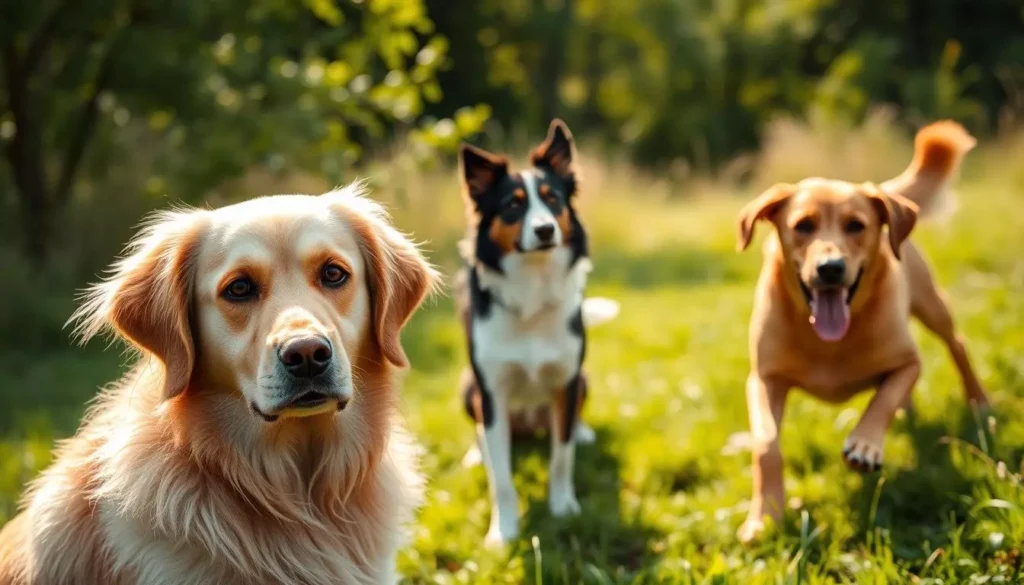
Rewards for Calm Behavior
Understanding the importance of rewards for dog behavior is key to a peaceful home. Dogs do well when they get positive feedback, especially for being calm. Using treats, praise, or toys as rewards helps my dog stay calm in different situations.
Timing is everything when rewarding calm behavior. When my dog is relaxed, I reward them right away. This teaches them that calmness equals good things. Regularly praising my dog for being calm helps us bond and feel secure together.
There are many ways to reward calm behavior. High-value treats work well in training sessions to grab my dog's attention. Verbal praise is great for everyday calm moments. Using both rewards helps my dog learn to seek out calm states, making calmness a good thing.
| Type of Reward | Benefits | Best Timing |
|---|---|---|
| Treats | High-value motivation, effective for training | Immediately after calm behavior |
| Verbal Praise | Strengthens bond, encourages positive feedback | Throughout the day, during calm moments |
| Toys | Engaging and fun, excellent for playtime calming | During downtime to celebrate peaceful behavior |
By using different rewards and techniques, I help my dog become calmer. Every small step makes my dog happier and better adjusted.
Calming Techniques for New Experiences
When introducing new experiences for dogs, it’s key to use calming techniques. This helps them feel secure. Transitioning to new places or meeting new people can be scary for pets. Using specific strategies can help dogs adjust more easily.
First, I suggest starting with small steps. For example, if my dog is nervous around guests, I let them approach at their own pace. This slow introduction helps them feel safer.
Creating a calming environment is also helpful. Using familiar scents, like a favorite blanket or toy, can make them feel secure. These items can help ease their anxiety.
Positive reinforcement is another important technique. I reward my dog with treats and praise when they stay calm. This teaches them to associate new experiences with good things. It motivates them to stay calm.
Finally, practicing relaxation exercises is beneficial. Techniques like deep breathing or gentle massage can prepare them for changes. These exercises help them build resilience against anxiety.
By using these strategies, I help my dog feel more at ease in different situations. This leads to a happier, more balanced dog.
Building Trust and Reducing Anxiety
Building trust with your dog is key to a strong bond. By being consistent and positive, my dog feels safer and more confident. I reward calm behavior, like during meals or play, to build trust.
This approach helps my dog feel more comfortable in different situations. It's a step towards reducing their anxiety.
To build trust, I use gentle methods. Simple commands and rewards create a special language. My dog learns what's expected and valued, reducing fear and uncertainty.
This clarity helps my dog thrive, especially in stressful situations. Meeting new people or visiting new places becomes less daunting.
Regular activities are vital in building trust. Daily walks, training, and playtime strengthen our bond. They also help my dog practice social skills.
Exploring the world together in a calm way reduces anxious behavior. It's a big part of my strategy for a happier, more confident dog.
Why Dogs Pick Up on Human Emotions
Dogs have a special gift for sensing our emotions. They can read our faces, body language, and how we sound. This dog-human emotion understanding helps them connect with us emotionally. They know how to react to our feelings.
My dog can pick up on my mood in ways I don't even notice. When I'm happy, they get excited and playful. But if I'm stressed, they calm down and protect me. This shows how much they care about our feelings.
Knowing how dogs feel our emotions helps with training. It makes our bond stronger. By paying attention to my feelings, I can train my dog better. This leads to a deeper understanding of each other.
Conclusion
Understanding my dog's actions is key to a strong bond. This article shared valuable techniques for better dog training. Trust and communication are crucial for a peaceful home, especially with guests.
Consistent practice and patience are essential in dog training. Regular sessions and knowing my dog's temperament help them feel secure and calm. This leads to better social interactions and a happier pet.
Every dog is different, and each one needs a tailored approach. By focusing on trust and structure, our life together will improve. This commitment leads to a more harmonious and joyful existence.

